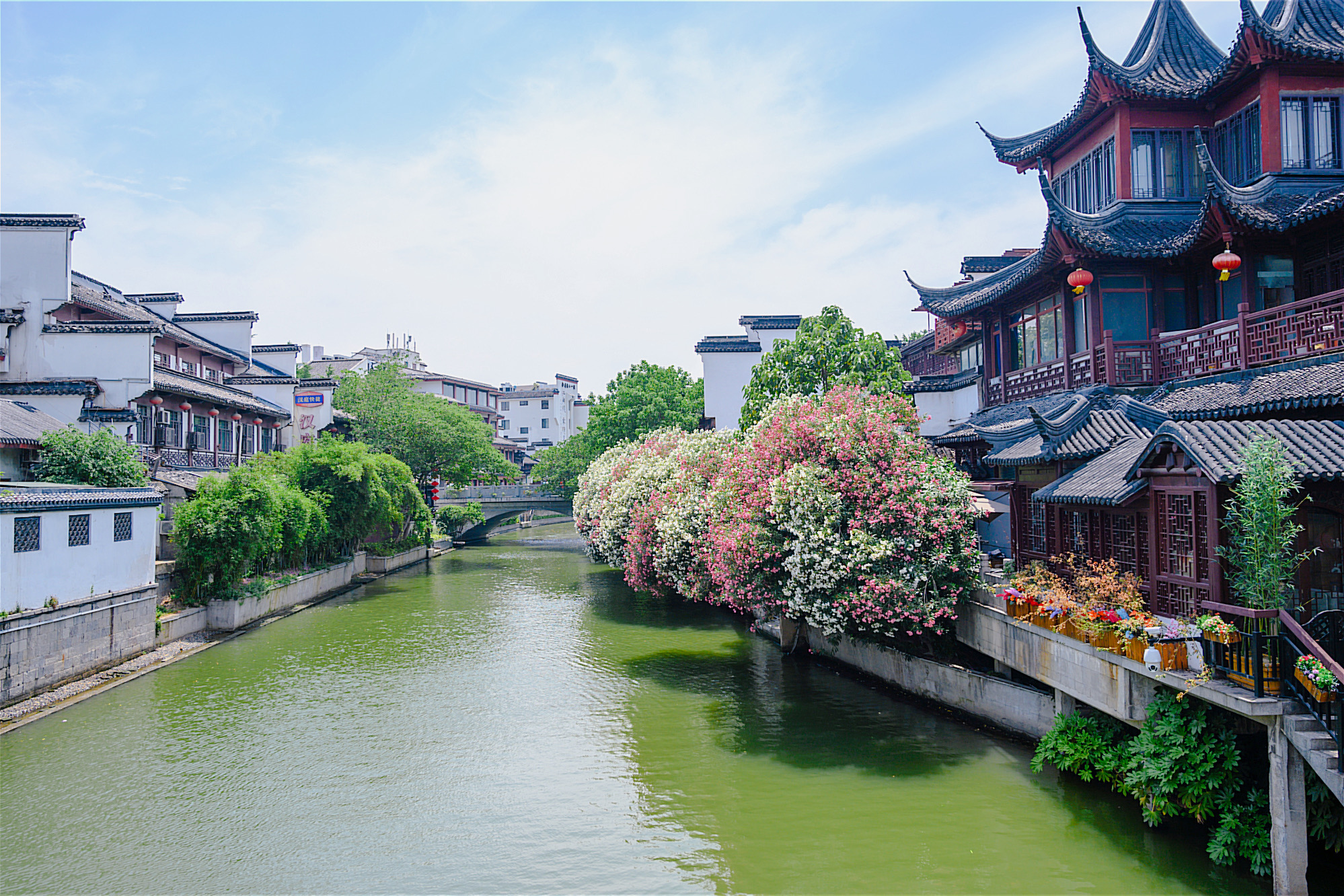
 *Changjiang|Yangtze River
*Changjiang|Yangtze River
 *Yangtze River Delta Economic Zone
*Yangtze River Delta Economic Zone
 China
China
 Chinese Super League 2019
Chinese Super League 2019

 History
History
 Jiangsu Sheng-JS
Jiangsu Sheng-JS
 Silk road
Silk road

 Vacation and Travel
Vacation and Travel

 World Heritage
World Heritage

 Important port
Important port





Nanjing (chinesisch 南京, Pinyin Nánjīng ‚Südliche Hauptstadt‘, ) ist eine bezirksfreie Stadt in der Volksrepublik China. Neben die Schreibung nach der offiziellen Pinyin-Transkription Nanjing sieht man heute vielfach noch die ältere deutsche Schreibweise nach Stange Nanking (mit Diakritikum: Nank’ing).[2] Nanjing ist Hauptstadt und Metropole der Provinz Jiangsu. Zudem war es Ende des 14. und Anfang des 15. Jahrhunderts Hauptstadt der Ming-Dynastie sowie 1927–49 Hauptstadt der Republik China, gehört damit zu den vier großen historischen Hauptstädten Chinas. Nanjings Kurzbezeichnung lautet Ning (寧 / 宁, Níngjīng ‚friedlich, ruhig‘), sie ist geschichtlich auch unter der Bezeichnung Jinling (金陵, Jīnlíng ‚goldener Hügel‘) bekannt. Die Stadt ist ein politisch kulturelles Zentrum Chinas mit einer langen Geschichte. Daher hat Nanjing im Chinesischen auch die Bezeichnung "Antikes Kapitol der sechs Dynastien" (六朝古都, Liù Cháo Gǔdū) bzw. "Metropole der zehn Dynastien" (十朝都會 / 十朝都会, Shí Cháo Dūhuì). Nanjing zählt 5.827.888 Einwohner im urbanen Stadtgebiet (Stand 2010) und 8.270.000 in der Agglomeration (Stand 2016). Somit ist Nanjing – hinter Shanghai – die zweitgrößte Stadt in Ostchina.
南京市(英文:Nanjing,邮政式拼音:Nanking),简称“宁”,别称金陵,是中华人民共和国江苏省省会、副省级城市和特大城市[7],华东地区区域中心城市。地处长江下游沿岸,位于江苏省西南部。是长江下游和长三角地区重要产业城市、长三角的副中心城市和中国东部暨江苏省的政治、经济、科教、文化、信息中心[8][9],也是全国综合性交通和通信枢纽城市以及科教中心城市之一[10]。
全市下辖11个区[11],总面积6582.31平方千米[4],2016年底常住人口827.05万,其中城镇人口678.14万人[12]。
南京有2500多年建城史和前后近500年建都史[13],先后有东吴、东晋、南朝宋、齐、梁、陈、南唐、明朝、太平天国、中华民国等十个朝代及政权定都南京[注 2],有“六朝古都”、“十朝都会”之称[注 3],历史上长期是中国南方的政治文化中心,亦被视为中华之正朔所在,是国家首批国家历史文化名城。
南京是全国重要科教文化中心,有八所大学列入全国百所重点建设大学,居各大城市第三位。根据自然出版集团发布的2016年自然指数,位居国内科研领先城市前三[14]。技术研发经费支出、发明专利数量名列前茅。新兴产业蓬勃,例如,软件与信息服务业居全国第四,新型显示产业居全国第二,智慧电网产业居全国首位,设有南京软件谷、智慧电网谷、生物医药谷、卫星应用产业园等多个产业园区[15]。有中国三大图书馆之一的南京图书馆[16]、三大博物馆之一的南京博物院[17]等。
南京是国家重要的科教中心,自古以来就是一座崇文重教的城市,有“天下文枢”、“东南第一学”的美誉,明清时期中国一半以上的状元均出自南京江南贡院。截至2016年,南京各类高等院校74所,其中111计划高校9所及学科25个,仅次于北京;211高校8所、双一流高校12所,仅次于北京上海;两院院士82人、千人计划特聘专家87人,均居中国第三。
南京市(ナンキンし、中国語: 南京市、拼音: (![]() 聞く)、英語: Nanjing)は、中華人民共和国の副省級市で、江蘇省の省都。古くから長江流域・華南の中心地で、かつては三国・呉、東晋、南朝の宋・斉・梁・陳(以上の6朝を総称して六朝)、十国の南唐や明といった王朝や南京国民政府の首都であった。中国四大古都の一つ。14世紀から15世紀にかけて、世界最大の都市であった[1]。2016年の都市的地域の人口は678.14万人であり、総人口は827万人である[2]。
聞く)、英語: Nanjing)は、中華人民共和国の副省級市で、江蘇省の省都。古くから長江流域・華南の中心地で、かつては三国・呉、東晋、南朝の宋・斉・梁・陳(以上の6朝を総称して六朝)、十国の南唐や明といった王朝や南京国民政府の首都であった。中国四大古都の一つ。14世紀から15世紀にかけて、世界最大の都市であった[1]。2016年の都市的地域の人口は678.14万人であり、総人口は827万人である[2]。
金陵(きんりょう)は南京の別名である。また清朝のころには江寧(こうねい、簡体字:江宁)と呼ばれたことから略称は「寧(簡体字:宁)」である。夏はとても暑く、重慶、武漢と並ぶ中国三大ボイラー(三大火炉)の一つと言われている。
南京の歴史は春秋時代に呉がこの地に城を築いたことに始まる。戦国時代に呉を征服した楚は金陵邑を設置。その後秦朝による統一事業が達成され、始皇帝がこの地に巡幸してきた際に、「この地に王者の気がある」と言われ、それに怒って地形を無理やり変えてこの地の気を絶とうとした。また名前も金から秣(まぐさ)の秣陵県と改称している。
三国時代になると呉の孫権が229年に石頭城という要塞を築いて建業と称してこの地に都を置いた。西晋にて一旦、建業とされた後に司馬鄴(愍帝)を避諱して建康と改められ、東晋及びその後の四王朝(宋、斉、梁、陳)の都となった。呉を含めた六国が全て同じ地に都を置いたことから六朝時代の名がある。
隋代には江寧県、唐代には金陵県、白下県、上元県と改称されている。隋唐代には新たに開削された大運河により、長江対岸の揚州が物資の集積地となり、この地域の中心地としての地位を奪われた恰好となり、往時の都としての繁栄は見られなくなった。唐崩壊後の五代十国時代には、南唐の都城である金陵府が置かれ、後に改名されて西都と称する。
明の太祖朱元璋(洪武帝)は1356年、集慶路と呼ばれていたこの地を征服し、以後ここを根拠地として全土を統一するに至った。1368年、応天府と改められ、首都とする。1421年には、靖難の役で皇位を簒奪した永楽帝により首都が北京(順天府)へ遷都され、「南京」と改められる。なお、この遷都に批判的であった息子の洪熙帝は即位後直ちに都を南京に戻そうとしたが、在位1年に満たずに急死したため計画は中止となる。このため、北京が国都として確定したものの、洪武帝の陵墓(明孝陵)のある南京もまた明朝創業の地として重要視されて副都としての扱いを受けた。明一代に於いて首都北京周辺の北直隷に対して副都南京周辺は南直隷とされ、南京には首都北京に異常があった際に備えて北京に置かれた朝廷を縮小したもの(南京六部)が置かれていた。1644年に北京が李自成の順軍によって陥落させられて明が滅びると、南京の官僚たちによって南京を首都とした亡命政権・南明が建てられたが翌年には清によって滅ぼされた。明代の南京の紫禁城は現在の故宮公園であり皇城の中に宮城があり、現在の故宮公園はかつての宮城の一部であり、門や主要建築物の石壇が残っている。ちなみに北京の紫禁城(故宮)も明の北京遷都の際、南京の紫禁城を模して建てたものであった(南京の紫禁城は靖難の役のとき攻城のあげく、焼却されてがれきとなった)。
清代に入ると江寧と呼ばれるようになった。太平天国の乱では占領され、天京とされた。また1858年の天津条約・1860年の北京条約に於いて西欧に対して開港した。
辛亥革命により中華民国が成立すると、1912年には一時的に臨時政府が置かれ、1927年4月には国民政府の首都となった。日中戦争(支那事変)中の1937年12月には日本軍によって占領された。
1940年3月に汪兆銘政権(南京国民政府)の首都となった。
1949年1月16日には国共内戦の結果、中華民国の中央政府は撤退し、4月23日には中国人民解放軍により占領された。同年10月1日に中華人民共和国が建国されると直轄地になるが、1953年に江蘇省の発足とともに同省の省都となった。1994年には副省級市になっている。なお、現在も中華民国は南京を「公式な首都」としている(詳細は「中華民国#首都」を参照)。
Nanjing (![]() listen), formerly romanized as Nanking and Nankin,[4] is the capital of Jiangsu province of the People's Republic of China and the second largest city in the East China region,[b] with an administrative area of 6,600 km2 (2,500 sq mi) and a total population of 8,270,500 as of 2016.[5] The inner area of Nanjing enclosed by the city wall is Nanjing City (南京城), with an area of 55 km2 (21 sq mi), while the Nanjing Metropolitan Region includes surrounding cities and areas, covering over 60,000 km2 (23,000 sq mi), with a population of over 30 million.
listen), formerly romanized as Nanking and Nankin,[4] is the capital of Jiangsu province of the People's Republic of China and the second largest city in the East China region,[b] with an administrative area of 6,600 km2 (2,500 sq mi) and a total population of 8,270,500 as of 2016.[5] The inner area of Nanjing enclosed by the city wall is Nanjing City (南京城), with an area of 55 km2 (21 sq mi), while the Nanjing Metropolitan Region includes surrounding cities and areas, covering over 60,000 km2 (23,000 sq mi), with a population of over 30 million.
Situated in the Yangtze River Delta region, Nanjing has a prominent place in Chinese history and culture, having served as the capital of various Chinese dynasties, kingdoms and republican governments dating from the 3rd century to 1949,[6] and has thus long been a major center of culture, education, research, politics, economy, transport networks and tourism, being the home to one of the world's largest inland ports. The city is also one of the fifteen sub-provincial cities in the People's Republic of China's administrative structure,[7] enjoying jurisdictional and economic autonomy only slightly less than that of a province.[8] Nanjing has been ranked seventh in the evaluation of "Cities with Strongest Comprehensive Strength" issued by the National Statistics Bureau, and second in the evaluation of cities with most sustainable development potential in the Yangtze River Delta. It has also been awarded the title of 2008 Habitat Scroll of Honor of China, Special UN Habitat Scroll of Honor Award and National Civilized City.[9] Nanjing boasts many high-quality universities and research institutes, with the number of universities listed in 100 National Key Universities ranking third, including Nanjing University which has a long history and is among the world top 10 universities ranked by Nature Index.[10] The ratio of college students to total population ranks No.1 among large cities nationwide. Nanjing is one of the top three Chinese scientific research centers, according to the Nature Index,[11] especially strong in the chemical sciences, and also strong in many other areas, for instance, it hosts the nation's best computer software laboratory and wireless communication laboratory in the IT field, as well as the state key laboratory for pharmaceutical biotechnology.
Nanjing, one of the nation's most important cities for over a thousand years, is recognized as one of the Four Great Ancient Capitals of China. It has been one of the world's largest cities, enjoying peace and prosperity despite wars and disasters.[12][13][14][15] Nanjing served as the capital of Eastern Wu (229–280), one of the three major states in the Three Kingdoms period ; the Eastern Jin and each of the Southern Dynasties (Liu Song, Southern Qi, Liang and Chen), which successively ruled southern China from 317–589; the Southern Tang(937–75), one of the Ten Kingdoms ; the Ming dynasty when, for the first time, all of China was ruled from the city (1368–1421);[16] and the Republic of China (1927–37, 1946–49) prior to its flight to Taiwan during the Chinese Civil War.[17] The city also served as the seat of the rebel Taiping Heavenly Kingdom (1853–64) and the Japanese puppet regime of Wang Jingwei (1940–45) during the Second Sino-Japanese War. It suffered severe atrocities in both conflicts, including the Nanjing Massacre.
Nanjing has served as the capital city of Jiangsu province since the establishment of the People's Republic of China. It boasts many important heritage sites, including the Presidential Palace and Sun Yat-sen Mausoleum. Nanjing is famous for human historical landscapes, mountains and waters such as Fuzimiao, Ming Palace, Chaotian Palace, Porcelain Tower, Drum Tower, Stone City, City Wall, Qinhuai River, Xuanwu Lake and Purple Mountain. Key cultural facilities include Nanjing Library, Nanjing Museum and Nanjing Art Museum.
Nankin ou Nanjing ([Écoutez] chinois : 南京 ; pinyin : ; EFEO : Nanking ; zhuyin : ㄋㄢˊ ㄐㄧㄥ ; littéralement : « capitale du Sud », à mettre en rapport à Pékin, 北京, , « capitale du Nord »), immédiatement en amont du delta du Yangzi Jiang, le premier fleuve chinois, est la capitale de la province chinoise du Jiangsu. La ville compte aujourd'hui plus de huit millions d'habitants. Elle a joué un rôle considérable dans l'histoire chinoise. La prise de la ville par les Japonais en 1937 s'accompagna d'un massacre dont l'ampleur n'est pas connue avec certitude.
Nankin a le statut administratif de ville sous-provinciale. L'abréviation chinoise du nom de la ville est níng (寧).
Nanchino (AFI: /nanˈkino/[1]; in cinese 南京S, NánjīngP, Nan-chingW, letteralmente "capitale [京, jīng] del sud [南, nán]") è un importante capoluogo della provincia dello Jiangsu in Cina, soprattutto se inserito nel contesto della storia e della cultura cinese, essendo stata, per lungo tempo, la capitale della Cina.
Situata nei pressi del bacino di drenaggio del fiume Azzurro e nella zona economica del delta, Nanchino è da millenni una delle più importanti città cinesi. È stata riconosciuta come una delle quattro grandi antiche capitali della Cina. Fu capitale del regno di Wu durante il periodo dei tre regni, e capitale ufficiale della Repubblica di Cina, anche se la capitale provvisoria di quest'ultima è Taipei, essendo Nanchino situata nella Repubblica Popolare Cinese. La città è anche una delle 15 località sub-provinciali della Repubblica Popolare Cinese, godendo di autonomia politica ed economica seconda solo a quella della provincia. Nanchino è un importantissimo centro nell'educazione, nella ricerca, nei trasporti, e nel turismo. La città ha ospitato i II Giochi olimpici giovanili estivi.
Con una popolazione urbana di oltre 8 milioni di abitanti (2010), Nanchino è il secondo polo commerciale della Cina orientale dopo Shanghai. È stata classificata seconda tra le "città con il maggior sviluppo sostenibile" secondo uno studio redatto dall'Istituto nazionale di statistica della Cina, e seconda tra le città con maggior sviluppo sostenibile potenziale del delta del fiume Azzurro. Ha anche vinto il premio d'onore della Cina e il premio d'onore delle Nazioni Unite[2].
Nankín1 (en chino: 南京市, pinyin: Nánjīng, transcripción antigua: Nanking, pronunciado [ nǎn.tɕíŋ](![]() escuchar), literalmente: la capital del sur) es una ciudad-subprovincia y la capital de la provincia de Jiangsu en la República Popular China, situada cerca del río Yangtsé. Es la segunda ciudad más grande de la región, después de Shanghái.
escuchar), literalmente: la capital del sur) es una ciudad-subprovincia y la capital de la provincia de Jiangsu en la República Popular China, situada cerca del río Yangtsé. Es la segunda ciudad más grande de la región, después de Shanghái.
Nankín, también es conocida como la "Capital de la Educación, la Ciencia, la Cultura, el Arte y el Turismo". Durante la Rebelión Taiping fue conocida como "La capital del cielo" Tianjing. Es una de las Cuatro capitales antiguas de China y fue la capital para diez dinastías o reinos. Ha sido el centro económico y político del sureste de China durante más de 1000 años. En la actualidad, es un importante centro turístico. Su población en 2012 era más de ocho millones de habitantes.
Нанки́н (кит. 南京, пиньинь: Nánjīng, палл.: Наньцзин [Слушать ], буквально — «южная столица») — бывшая столица Китая, порт в низовьях реки Янцзы, столица провинции Цзянсу.
Расположен в восточной части страны, в 260 км к северо-западу от Шанхая.Крупный промышленный и культурный центр. Население — 8 187 800 человек (2013)[1].
Время основания достоверно не известно. Согласно легенде, цитируемой художником Чен И, жившим во времена династии Мин, правитель царства У, Фучай, основал форт Ечэн в районе современного Нанкина в 495 году до н. э.[2] Позднее, в 473 году до н. э. царство Юэ завоевало У и возвело форт Юэчэн на окраине сегодняшних Врат Китая[zh].
Город несколько раз менял названия (см. Цзянькан), столица Восточной Цзинь, 316—420).
В середине XIV века Нанкин был очагом восстания против монгольской империи Юань. Он стал столицей одного из лидеров повстанцев, Чжу Юаньчжана, который в 1368 году провозгласил здесь новую империю Мин, а сам стал её первым императором (девиз правления Хунъу). В 1368—1421 годах служил столицей Хунъу и его преемников Цзяньвэня и Юнлэ. В царствие Хунъу Нанкин был обнесён мощной крепостной стеной; для самого же императора был сооружён грандиозный мавзолейный комплекс Сяолин у подножия Горы пурпурного золота (Цзыцзиньшань) к востоку от города.
Уже в 1403 году, в самом начале царствия Юнлэ на судоверфи Лунцзян («Драконовая река»), расположенной под стенами Нанкина, на реке Циньхуай[zh] близ её впадения в Янцзы, развернулось строительство огромных кораблей для экспедиций Чжэн Хэ в Индийский океан[3].












